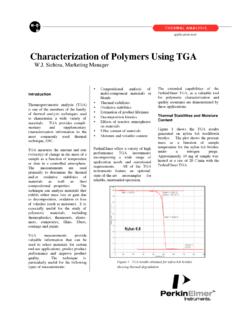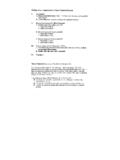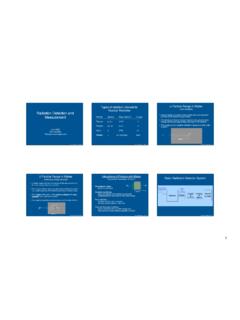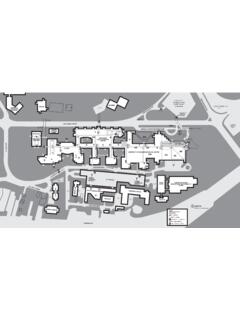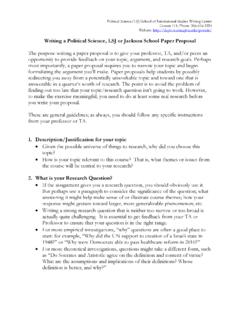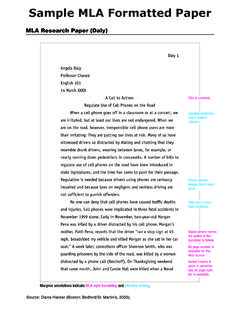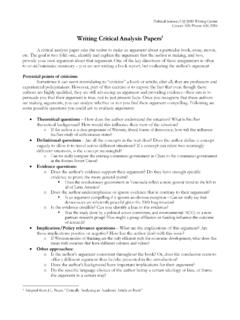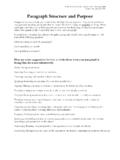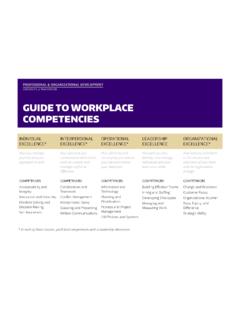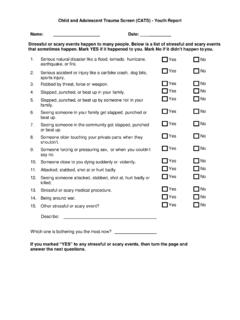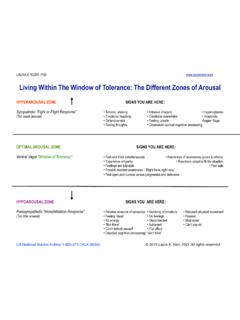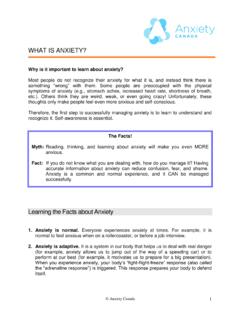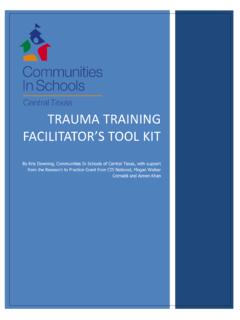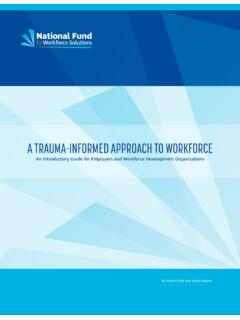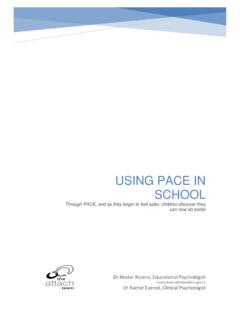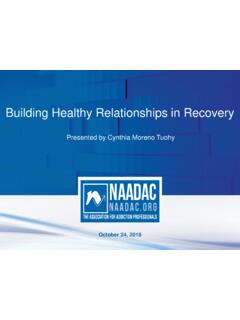Transcription of The Pathophysiology of Stress
1 The Pathophysiology of Stress (Chronic Stress is Bad). (Overwhelming Stress is Worse). Frank F. Vincenzi, Stress l Emotional l Environmental l Physiological l Stress is a condition or feeling experienced when a person perceives that "demands exceed the personal and social resources the individual is able to mobilize. (attributed to Richard ). l " Stress is not what happens to you, but how you react to what happens l we define Stress as environmental conditions that require behavioral adjustment (Benson, H. The Relaxation Response, 2000, pg. 41). l Thus, change, good or bad, can induce a Stress response. (Holmes and Rahe Life Events Rating Scale). Check your own Life Events Rating Scale at: Selected (of 43) Life Change Units l Death of Spouse 100. l Divorce 73. l Jail term 63.
2 L Death of close family member 63. l Marriage 50. l Fired at work 47. l Retirement 47. l Gain of a new family member 39. l Large mortgage or loan 31. l Trouble with boss 23. l Change in residence 20. l Vacation 13. l Christmas 12. l Minor violations of law 11. Holmes, TH & Rahe, RH, J Psychosomatic Research 11: 213-218, 1967. Instinct vs. Culture The acute Stress response was essential to survival in a time when human beings faced many physical threats Instinct vs. Culture Stresses of modern life are more likely to be chronic and often psychological and interpersonal. ( , Holmes & Rahe). Unfortunately the body reacts to today s stresses as though it were still facing a real physical threat.. Some Major Avenues of Mind-Body Reciprocity l Nervous System l Endocrine System l Immune System Optimally, interaction of these systems maintains homeostasis and wellness Stress -Induced Changes in the Nervous System l Classical View of the Autonomic Nervous System l Parasympathetic l Rest and restoration l Sympathetic l fight or flight The Parasympathetic Nervous System l Integrates the rest & recreation' (feed & breed).
3 Response*. l Release of acetylcholine l Decreased heart rate & blood pressure l Decreased respiratory rate and bronchial constriction l Decreased glycogen to glucose in liver l Pupillary constriction l Increased GI activity *Also known as rest and restoration or rest and RELAXATION (emphasis added) The Sympathetic Nervous System l Integrates the fight or flight response l Release of norepinephrine & epinephrine l Increased heart rate & blood pressure l Increased respiratory rate and bronchial dilation l Increased glycogen to glucose in liver l Increased pupil diameter l Decreased GI activity Important: Sympathetic responses to acute Stress normally dissipate quickly$. The fight or flight Response l Integrates the fight or flight response l Release of norepinephrine & epinephrine l Increased heart rate & blood pressure l Increased respiratory rate and bronchial dilation l Increased glycogen to glucose in liver l Increased pupil diameter l Decreased GI activity The fight or flight Response Dissipates Quickly Sometimes fight or flight is not enough The Autonomic Nervous System: But wait there's more!
4 L Parasympathetic l Rest and relaxation l Sympathetic l fight or flight freeze or feigned death The freeze or Feigned Death Response Tonic immobility is most useful when a slow-moving vulnerable organism is confronted with a life- threatening situation involving mobile, large predators. Tonic immobility may enhance survival when a predator temporarily loosens its grip on captured prey under the assumption that it is indeed dead, providing the prey with an opportunity for escape. It is also a response that may be adaptive in humans when there is no possibility of escaping or winning a fight .. $. A New View of the Autonomic Nervous System: Polyvagal Theory l Parasympathetic Mammalian' (myelinated) vagus Origin in the nucleus ambiguus (ventral). Fine tuning of daily life especially social intx Reptilian' (unmyelinated) vagus Origin in the dorsal motor nucleus of the vagus Activated in perceived life-threatening danger Porges (2011) The Polyvagal Theory, Norton Activation of the Unmyelinated Vagus Acute - extreme threat situations Profound bradycardia freeze Hypotension, fainting Near death experience ?
5 Chronic in perceived extreme threat The General Inhibition Syndrome . Helplessness and avoidance Persistent in post-traumatic Stress disorder Note: Activation of the reptilian vagus also inhibits the sympathetic nervous system and somatic muscles, inactivating fight or flight . Polyvagal Theory by Stephen W. Porges Graphic by Ravi Dykema Some Stress -Induced Changes in Endocrine Function l Increased cortisol, catecholamines & fatty acids l Increased blood sugar (see above). l Increased insulin (see above). l Inc (LDL) cholesterol, (dec HDL). Brindley et al. (1993) Metabolism 42: Supp1, 3-15. Homeostasis vs. Allostasis l Homeostasis: balance of systems essential for life, pH, body temperature, [glucose], pO2. l Allostasis : changes in the body that occur as a consequence of CHRONIC activation of homeostatic mechanisms (McEwen et al.)
6 L Catecholamines l HPA axis l Cytokines l Stress and Development of Allostatic Load Perception of Stress is influenced by one's experiences, genetics, and behavior. When the brain perceives Stress , physiologic and behavioral responses are initiated leading to allostasis and adaptation. Over time, allostatic load can accumulate, and the overexposure to neural, endocrine, and immune Stress mediators can have adverse effects on various organ systems, leading to disease. McEwen (1998) N Engl J Med 338:171-179. Allostatic Overload: Wear and Tear on the Body Caused by Chronic Stress l Decreased immune functions l Hypertension l Atherosclerosis l Increase platelet reactivity l Abdominal obesity l Bone demineralization l Atrophy of neurons in hippocampus and prefrontal cortex l Increased activity of amygdala McEwen (2004) 1032: 1-7.
7 Stress associated hormonal and neurohormonal changes Henry and Wang (1998). Psychoneuroendocrinology 23: 863-875. Items in the AL index A clinical allostatic load cortisol (AL) is associated with c-reactive protein burnout and creatinine hypocortisolemic profiles fibrinogen glycosylated haemoglobin in healthy' workers insulin pancreatic amylase systolic and diastolic BP. total cholesterol triglycerides waist-hip ratio albumin dehydroepiandrosterone HDL cholesterol Juster et al. (2011) Psychoneuroendocrinology 36: 797-805. Chronic Stress versus AL. Burnout symptoms versus AL. Juster et al. (2011) Psychoneuroendocrinology 36: 797-805. Hypocortisolemic profiles in subject with high allostatic load index. Juster et al. (2011) Psychoneuroendocrinology 36: 797-805. Stress -Induced Changes in Immune Function l Eustress (acute, physiologically adaptive).
8 L Increased delayed type hypersensitivity, associated with acute spikes in corticosterone and decreased leukocytes in blood (by movement to skin). l Distress (chronic, physiologically maladaptive). l Decreased delayed type hypersensitivity, associated with chronically increased basal corticosterone and less decrease in blood leukocytes ( , less movement of leukocytes to skin). Dhabhar & McEwen (1997) Brain Behav Immun 11: 286-306. Stress and Illness in Practice l Review of audiotapes of primary care practice of patients with chronic-disease (better, chronic illness). l 439 interactions with 49 physicians l Stress was by far the most time consuming topic. l Nearly 60% of the discussions were not perfunctory but attempts to counsel or encourage behavior change in the patient (It has been estimated that 70-80% of primary care visits involve an illness that is caused or augmented by Stress ).
9 Russell & Roter (1993) Am J Public Health 1993; 83: 979-982. Nortin Hader on NPR Oct 4, 2007. Medical care can change what you die of, but does not change much when you die We can capture about 80% of the mortal risk [of WHEN you die] by the answer to two questions: . Are you comfortable in your socio-economic status? Are you happy in your job? Hadler (2004) The Last Well Person: How to Stay Well Despite the Health-Care System, McGill-Queen's University Press Work-Related Stress and Illness l 10,308 civil servants in the UK. l Work Stress = poor work social support, high job demands, and low job control l Associated with increased risk of BMI obesity (odds ratio, ), and waist obesity (odds ratio, ). l Men were more likely than women to suffer the negative effects of job strain in terms of obesity.
10 Women did not experience a significant increase in waist obesity with Stress . Brunner et al. (2007) Am J Epidemiol 165:828-837. A Gender Difference in Stress Management? l Female responses are more marked by a pattern of "tend-and-befriend. ! l Nurturant activities designed to protect the self and offspring promote safety and reduce distress! l The tend-and-befriend pattern appears to draw on the attachment-caregiving system! l Neuroendocrine evidence suggests that oxytocin, in conjunction with female reproductive hormones and endogenous opioid peptide mechanisms, may be at its core ! Taylor et al. (2000) Biobehavioral responses to Stress in females: tend-and-befriend, not fight -or- flight , Psychol. Rev. 107: 411-429. The Tending Instinct fight or flight may assure survival in the short term, but an individual is not likely to survive for long if he or she tries to go it alone.
